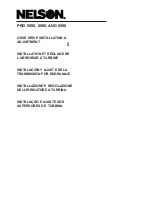
Chapter 4
Connecting Signals
©
National Instruments Corporation
4-39
The ADC switches to hold mode within 60 ns of the selected edge. This
hold-mode delay time is a function of temperature and does not vary from
one conversion to the next. Separate the CONVERT* pulses by at least one
conversion period.
The sample interval counter on the AT E Series device normally generates
the CONVERT* signal unless you select some external source. The counter
is started by the STARTSCAN signal and continues to count down and
reload itself until the scan is finished. It then reloads itself in readiness for
the next STARTSCAN pulse.
A/D conversions generated by either an internal or external CONVERT*
signal are inhibited unless they occur within a DAQ sequence. Scans
occurring within a DAQ sequence may be gated by either the hardware
(AIGATE) signal or software command register gate.
AIGATE Signal
Any PFI pin can externally input the AIGATE signal, which is not
available as an output on the I/O connector. The AIGATE signal can mask
off scans in a DAQ sequence. You can configure the PFI pin you select as
the source for the AIGATE signal in the level-detection mode. You can
configure the polarity selection for the PFI pin for either active high or
active low. In the level-detection mode if AIGATE is active, the
STARTSCAN signal is masked off and no scans can occur.
The AIGATE signal can neither stop a scan in progress nor continue a
previously gated-off scan; in other words, once a scan has started, AIGATE
does not gate off conversions until the beginning of the next scan and,
conversely, if conversions are being gated off, AIGATE does not gate them
back on until the beginning of the next scan.
SISOURCE Signal
Any PFI pin can externally input the SISOURCE signal, which is not
available as an output on the I/O connector. The onboard scan interval
counter uses the SISOURCE signal as a clock to time the generation of the
STARTSCAN signal. You must configure the PFI pin you select as the
source for the SISOURCE signal in the level-detection mode. You can
configure the polarity selection for the PFI pin for either active high or
active low.
The maximum allowed frequency is 20 MHz, with a minimum pulse width
of 23 ns high or low. There is no minimum frequency limitation.
















































